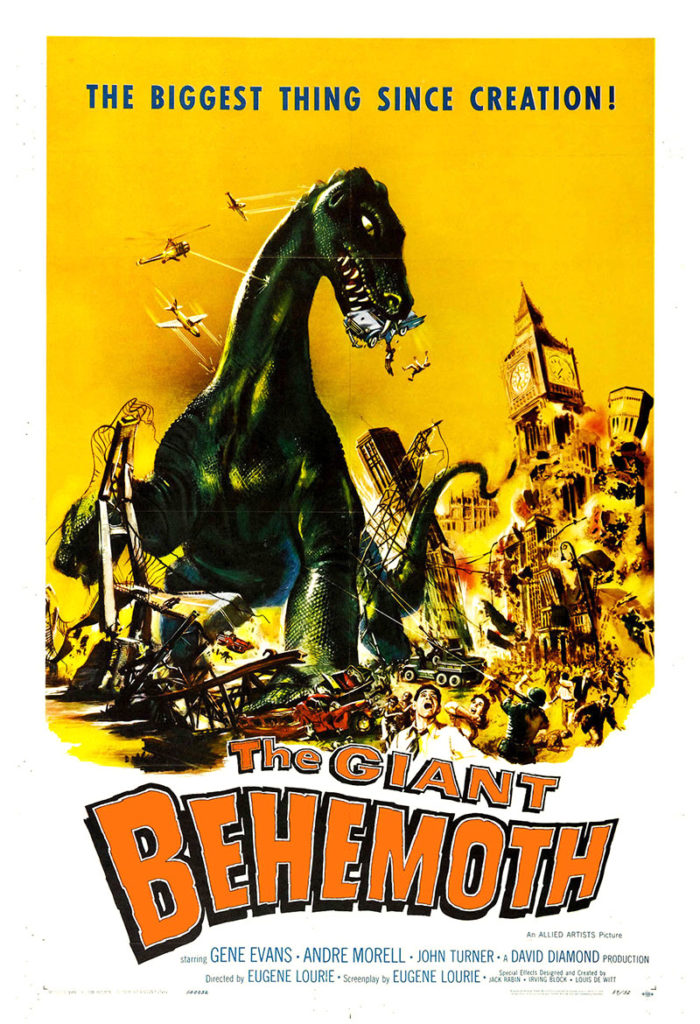Filmmaker Eugène Lourié must have thought that his 1953 film, The Beast from 20,000 Fathoms, was just practice — a full dress rehearsal, of sorts. How else to explain Lourié directing what is, essentially, a remake of that film?
The Giant Behemoth, released in 1959, comes to viewers from Hollywood Poverty Row stalwart Allied Artists, the studio behind such classics as Attack of the Crab Monsters and House on Haunted Hill. There are conflicting stories floating around on the internet about today’s film. Either Allied demanded script changes that resulted in a film that aped 20,000 Fathoms, or Lourié had enough creative control to take the film in that direction. He is listed as one of the screenwriters, after all. Without digging into the documentary history of a long-dead movie studio, there really can’t be an answer. But considering Lourié shared directing credits for this film with Douglas Hickox, that points to the moneymen having control over this film, despite Lourié getting a screenwriting credit. Who knows?
An American scientist, Steve Karnes (Gene Evans), has a dire message. The testing of nuclear bombs is irradiating the food chains of the world’s oceans. It starts with plankton, and moves all the way up to all the creatures that feed on fish. Concentrations of radioactive materials increase the higher up the food chain one goes. Karnes warns of a possible nightmare scenario whereby the high concentrations of radioactivity in higher ocean life forms could lead to strange mutations or poison  a vital food source for civilization. He isn’t exactly laughed out of the room when he makes such claims, this flick taking place in staid old England, but he is dismissed out of hand. Fans of giant monster flicks, and readers of the Giant Monstershow, will know where this is going.
a vital food source for civilization. He isn’t exactly laughed out of the room when he makes such claims, this flick taking place in staid old England, but he is dismissed out of hand. Fans of giant monster flicks, and readers of the Giant Monstershow, will know where this is going.
Soon after, a giant creature, a dinosaur of generic design, begins making appearances on the Cornish coast. Besides being a big beasty, the radioactivity the creature absorbed from the nuclear tests gives it the ability to shoot deadly radiation outwards at any person who happens to be nearby, flash-frying them in their own skins.
Karnes learns of the happenings in Cornwall and heads there to investigate, because this film uses all the well-worn tropes of giant monster flicks in that decade, with the exception of teenagers. Teen heroes was strictly an American conceit in these types of films.
Through some exposition provided by paleontologist Dr. Sampson (an overacting Jack MacGowran), viewers learn that the monster is headed to the Thames estuary, because these creatures always seek out fresh water, or some such nonsense. Why the creature needs to go all the way to the Thames from Cornwall in order to find a river is never hinted at, much less explained, but I have an explanation. The filmmakers wanted their monster to stomp London, so the script had just enough nonsense lines thrown in to put London in the crosshairs.
So, for the final act, we viewers get some satisfying scenes of the monster rampaging through London, and Karnes and company trying to find a way to kill it. There wasn’t much of a budget, so the work of the special effects team, which included an uncredited Willis O’Brien, is a little lean. The creature is somewhat underbuilt, and the stop motion is jumpy. There’s also model work that is only slightly better than that of Kaiju films of the era. But, despite these limitations, the work is professional. The process shots in this film showcase the massive differences between the professional workshop used by this film, and what Bert I. Gordon would shoot in his garage. The monster integrates very well into shots, with only minor hiccups along the way.
This film is very earnest. It’s full of serious performances from start to finish. It’s lack of lightness feels very British, if that makes sense. Of course the British would approach such an outlandish subject with seriousness. That makes the absurdity of the enterprise all the more apparent. But, it’s still a b-movie. Besides the special effects, there are all sorts of moments of cheapness spread throughout the film.
My personal favorite was some of the Foley work. Being a film about a radioactive monster, there were bound to be Geiger counters in this movie. But the Foley team didn’t bother with finding audio from a real Geiger counter. Instead, it sounds like they had a crank and just turned it faster or slower to speed up or slow down some clicking sounds as needed.
The Giant Behemoth may be just a version of The Beast from 20,000 Fathoms that takes place in England, but so what? The same stories get told over and over again in film, sometimes in the same year. It doesn’t matter, really, that Lourié decided to make a return trip to the well. The result, actually, is better this time around, even though there is nothing much to make this film stand out. It’s not great cinema, nor does it offer the laughable incompetence of a Gordon film. It’s just a 1950s monster flick.
